The Individual Processes: Motivation (Organisational Behaviour and Design)
Motivation is a mental characteristic that stimulates person to act towards a needed goal and elicits, controls, and maintains certain goal-directed behaviours. It is a driving force; a psychological one that reinforces an action toward a desired goal. Motivation pushes person intrinsically to work for attaining individual as well as organizational goals. The major role of managers is to apply numerous motivational factors in workplace to content employees for good productivity. Many research reports indicated that employee’s will improve the work pace of the organization. Their contributions and commitments will originate out of imagination, innovation and enthusiasm to push the organization to the next level. It is advised to management team to motivate their workers and make proper adjustments in order to attain desired goals. Theorists stated that motivation is the purpose or psychological cause of an action (Schater 2011). Slocum and Hellriegel 2007 affirmed that motivation represents the forces acting on or within a person that cause the person to behave in a specific, goal-directed manner. It can be supposed that motives of workers affect their productivity and management’s jobs are to channel employee motivation successfully toward achieving organizational objective. Frederick (1993) described it as what drives or induces a person to behave in a particular fashion, the internal forces which initiates, directs, sustains and terminates all important activities. It influences the level of performance, the efficiency achieved and the time spent on an activity.
Different sources of motivation subsist and these can have either positive or negative consequences on a human being. Many psychological researches have been conducted to demonstrate that internal motivations are preferred in making a person to work towards the achievement of goals. Though, external motivations still contribute to drive a person towards the accomplishment of organizational goals.
Intrinsic motivation: Intrinsic motivation occurs when people engage in an activity, such as a hobby, without obvious external incentives. Carol, (2013) described that intrinsic motivation is the pleasure one gets from the task itself or from the sense of satisfaction in completing or even working on a task. Intrinsic motivation does not signify that a person will not search for rewards. It is just that external rewards are not enough to keep such a person motivated. James (1998) stated that intrinsic motivation is a choice of person to perform certain task and there are no convincing reasons.

Extrinsic Motivation: Extrinsic motivation is associated with tangible rewards such as salary and fringe benefits, security, promotion, contract of service, the work environment and conditions of work. Nnaji (2013) stated that extrinsic motivation, sometimes financial, is the tangible motivations given to employees by managers, such as pay raises, bonuses, and benefits. They are called “extrinsic” because they are external to the work itself and other people control their size and whether or not they are granted. Intrinsic motivations are psychological motivations that employees get from doing important work and performing it well. Extrinsic motivation has vital role in previous time, when work was generally more routine and bureaucratic, and when complying with rules and procedures were paramount. Extrinsic motivation remains important for workers. Pay is an important consideration for most workers to accept a job, and unjust pay can be a strong de-motivator. However, after people have taken a job and issues of unfairness have been settled, it is found that extrinsic motivation are less important, as day-to-day motivation is more powerfully driven by intrinsic motivations.
Attributes of Motivation: Motivation is a psychological fact. It is the internal desire of an individual to accomplish something more. The very deficiency forces him to undertake certain amount of work. Motivation is a continuous process. Since need is a continuous phenomenon if one need is satisfied the other need emerges and so does individual propels to work and thus the continuous chain is created. Motivation is caused due to predictable perceived value from an action. Perceived value is the probability or the expectancy. There are unfulfilled needs. A person remains disturbed till they are satisfied. This disturbance or tension causes disequilibria in human behaviour. More the motivation level, the higher will be efforts to get over the tension and in the process job accomplishment would take place. Individual is motivated by positive motivation. It refers to incentives offered by the organization to achieve efficiency. Incentive can be monetary like increase in pay, allowances, and payment of bonus.
Significance of Organizational Motivation
Motivation is vital element to determine organizational effectiveness. All organizational resources and facilities will be ineffective if there are not motivated employees to utilize these resources successfully. Management team in the organization must encourage its subordinates for good behaviour. The performance of workers in the organization is dependent on the ability rooted in motivation. A management theorist Rensis Likert explained motivation as “the cost of the management” motivation is an effective instrument in the hands of management in inspiring the workforce. Motivation increases the readiness of the workforce to work, therefore increasing efficiency and success of the organization. Motivation guarantees best utilization of all resources. Consequently people should be motivated to execute the plans, policies and programmes laid down by the organization. Motivation bridges the gap between capacity to work and enthusiasm to work.
Theoretical framework: There are numerous theories developed by psychologists to explain motivation in workplace. Some theories assert that the role of social processes in the organization is very important, as long as the need of belongingness is significant than money. Others group of theorists consider organizational reward system as a possibility to motivate employees. It has been found that there is no correct approach to motivation; every individual has its own “needs theory”, therefore knowing how to motivate employees is critical managerial skill.
Classification of motivational theories: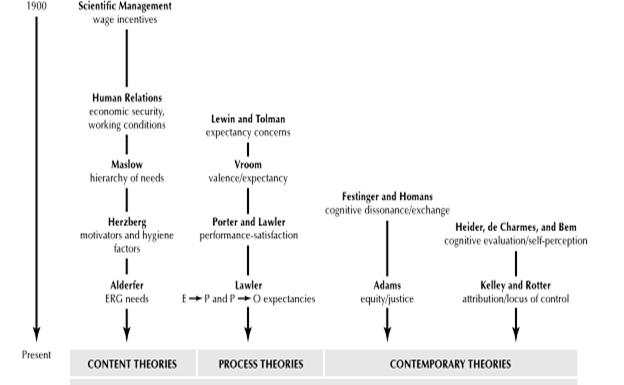
Abraham Maslow developed The Need Hierarchy theory in 1943. Theory lists a hierarchy of five need levels:
Physiological needs, or the need for basic necessities such as food, water, and shelter.
Safety needs, or the need for security in both home and work.
Social needs, or the need for loving, acceptance, and group affiliation.
Esteem needs, or the need for recognition and acknowledgment, and self-respect.
Self-actualization needs, or the need to develop to one's fullest potential.
An employee works his way up the need hierarchy, and on fulfilling a need level, aspires for the next level. For example, an employee already having attained recognition and acknowledgment no longer remains motivated by rewards such as recognition and acknowledgment, and would instead require opportunities for self-actualization to remain motivated. On the other hand, an employee frustrated by the incapability to fulfil higher-level needs may strive to fulfil lower level needs.
Clayton Alderfer proposed need theory and recommended that as more concrete needs are satisfied, less concrete need become more important. Instead of the five deeds that Maslow believes should be satisfied; he said that there are three important needs such as existence, relatedness, and growth. ERG theory includes a unique frustration-regression component. This suggests that an already satisfied need can become activated when a higher need cannot be satisfied. Thus, if a person is continually frustrated in his or her attempts to satisfy growth needs, relatedness needs can again surface as key motivators. ERG theory offers a more flexible approach to understanding human needs than does Maslow’s strict.
Alderfer’s ERG Theory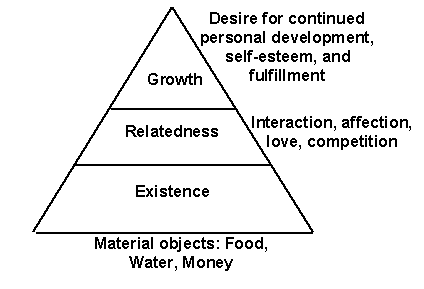
Herzberg theory of motivation described that jobs that do not offer achievement, recognition, stimulating work, responsibility and advancement cannot provide satisfaction while jobs that offer achievement, recognition, stimulating work, responsibility and advancement provide satisfaction, and hence motivation. Herzberg demonstrated that satisfaction and dissatisfaction at work always arose from different factors, and were not simply opposing reactions to the same factors, as had always previously been believed. Herzberg's theoretical framework categorized motivation into two factors: Motivators and hygiene (Herzberg, Mausner, and Snyderman, 1959). Motivator or intrinsic factors, such as achievement and recognition, produce job satisfaction. Hygiene or extrinsic factors, such as pay and job security, produce job dissatisfaction.
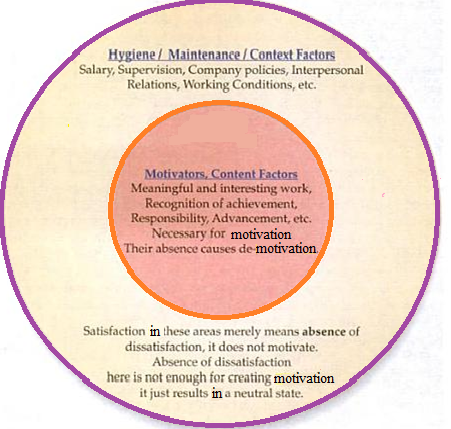
Vroom's theory proposed that employee effort will lead to performance and performance will lead to rewards (Vroom, 1964). Rewards may be either positive or negative. The more positive the reward the more likely the employee will be highly motivated. Conversely, the more negative the reward the less likely the employee will be motivated. The Expectancy theory explains that employee’s motivation is a result of how much an individual wants a reward (Valence), the assessment that the likelihood effort will lead to expected performance (Expectancy) and the belief that the performance will lead to reward (Instrumentality). Major benefits of this theory are that it is based on self-interest individual who wants to achieve maximum satisfaction and who wants to minimize dissatisfaction. This theory focuses on the expectations and perception; what is real and actual is immaterial. It highlights on rewards or pay-offs. It focuses on psychological extravagance where ultimate objective of individual is to get maximum pleasure and least pain. There are some drawbacks of this theory. The expectancy theory seems to be unrealistic because few individuals perceive high degree correlation between performance and rewards. The application of this theory is restricted as reward is not directly correlated with performance in several organizations. It is related to other parameters also such as position, effort, responsibility, education.
Figure: Expectancy theory of Vroom
Porter and Lawler expanded the theoretical concept of Vroom’s theory (1968). It is most comprehensive theory of motivation. Basically, a Porter and Lawler’s model demonstrated that the amount of effort generated depends upon the value of the reward, the amount of effort seen to be necessary, and the probability of receiving the reward.
Porter and Lawler theory of Work Motivation (Rudani, 2011)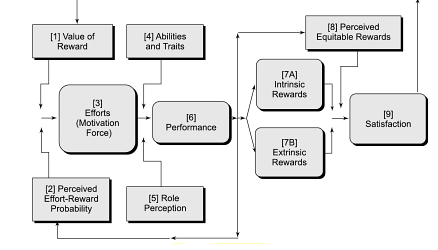
Another influential theoretical modal represented by Adams' that states employees strive for equity between themselves and other workers. Equity is accomplished when the ratio of employee outcomes over inputs is equal to other employee outcomes over inputs (Adams, 1965). Equity theory indicates that workforce compare the reward potential to the effort they must expend. Equity exists when workers see that rewards equal efforts. Equity theory is most appropriate for managers in maintaining employee’s motivation on the job. Managers are attracted toward this theory because equity theory is most appropriate to pay as an outcome. Pay is an actual measure of person’s importance to organization. Managers may control unwanted problems which arise due to unfairness by distributing rewards on the basis of performance. According to Adams, outputs are usually, financial rewards or intangible emotional benefits that are oriented from input.
Equity theory of work motivation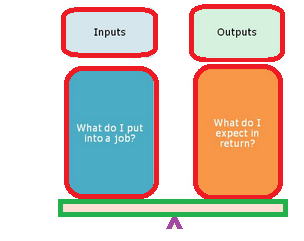
Skinner's theory proposed those employees' behaviours that lead to positive outcomes will be repeated and behaviours that lead to negative outcomes will not be repetitive (Skinner, 1953). Managers should positively strengthen employee behaviours that lead to positive outcomes. Managers should negatively reinforce employee behaviour that leads to negative outcomes. Reinforcement theory of motivation overlooks the internal state of individual. Skinner believed that more complex learning could be achieved by this process of contingencies and reinforcement ". Through successive stages in the shaping process, the contingencies of reinforcement being changed progressively in the direction of the required behaviour" (Skinner, 1968).
David McClelland and his associates developed theory of Needs and Achievement Motivation. This theory explained that human behaviour is affected by three needs that include Need for Power, Achievement and Affiliation. McClelland’s need theory is strongly associated with learning theory, because he believed that needs are learned or acquired by the kinds of events people experience in their environment and culture. He found that people who obtain a particular need behave differently from those who do not have.
Edwin Locke put forwarded important theoretical modal of the Goal-setting theory of motivation. This theory describes that goal setting is basically linked to task performance. It denotes that specific and challenging goals along with appropriate feedback contribute to higher and better task performance. Goals designate and guide an employee about what needs to be done and how many efforts are required to be put in. The important characteristics of goal-setting theory are as follows:
The willingness to work towards attainment of goal is main source of job motivation. Clear, particular and difficult goals are greater motivating factors than easy, general and vague goals.
Specific and clear goals lead to greater output and better performance. Unambiguous, measurable and clear goals accompanied by a deadline for completion avoids misunderstanding.
Goals should be realistic and challenging. This gives an individual a feeling of pride and triumph when he attains them, and sets him up for attainment of next goal. The more challenging the goal, the greater is the reward generally and the more is the passion for achieving it.
Better and appropriate feedback of results directs the employee behaviour and contributes to higher performance than absence of feedback. Feedback is a means of gaining reputation, making clarifications and regulating goal difficulties. It helps employees to work with more involvement and leads to greater job satisfaction. Employees’ participation in goal is not always desirable. Participation of setting goal, however, makes goal more acceptable and leads to more involvement.
In contemporary theoretical structure, cognitive evaluation theory has significance. This theory is a forerunner of self-determination theory and centres on the difference between intrinsic and extrinsic motivation (Lens, & Deci, 2006). When individuals experience intrinsic motivation, they engage in behaviours they perceive as inherently interesting, satisfying, gratifying, enjoyable, fulfilling, and absorbing. When individuals experience extrinsic motivation, they engage in behaviours just because of the objective consequences they might attract, such as tangible rewards or praise. In contrast to extrinsic motivation, intrinsic motivation tends to enhance persistence, well-being, and creativity. In modern concept of motivation, attribution theory has great significance. Attribution theory is related with how individuals understand events and how this relates to their thinking and behaviour. Weiner concentrated his attribution theory on achievement (Weiner, 1974). He recognized ability, effort, task difficulty, and luck as the most important factors affecting attributions for achievement. Attributions are classified along three causal dimensions; locus of control, stability, and controllability. The locus of control dimension has two poles; internal versus external locus of control. The stability dimension captures whether causes change over time or not.
To summarize, in modern work environment, there is a necessity of motivated workforce which can improve the work pace of the organization. They will add to what is obtainable in the organization. Their contributions and commitments will originate out of creativity, innovation and enthusiasm to push the organization to higher level. Management team must make proper adjustments in order to attain desired ends. Motivating workers to complete their work correctly and on time is one of the major tasks of management. Motivation leads to goal directed behaviour. It assists people to move in a desired direction and earn rewards. In organisations where managers try to understand the needs of employees and introduce appropriate incentive systems, it is easy to attain desired goals.

